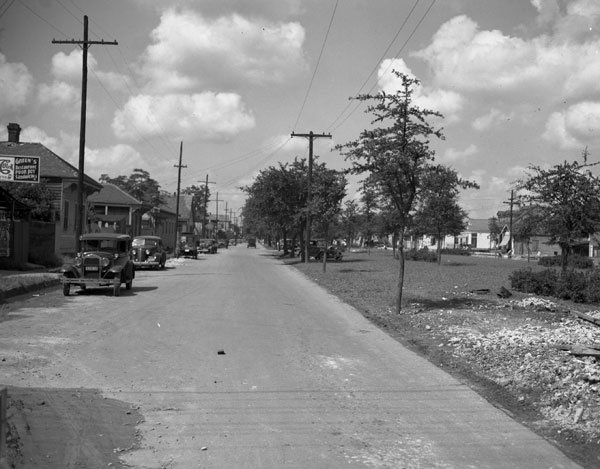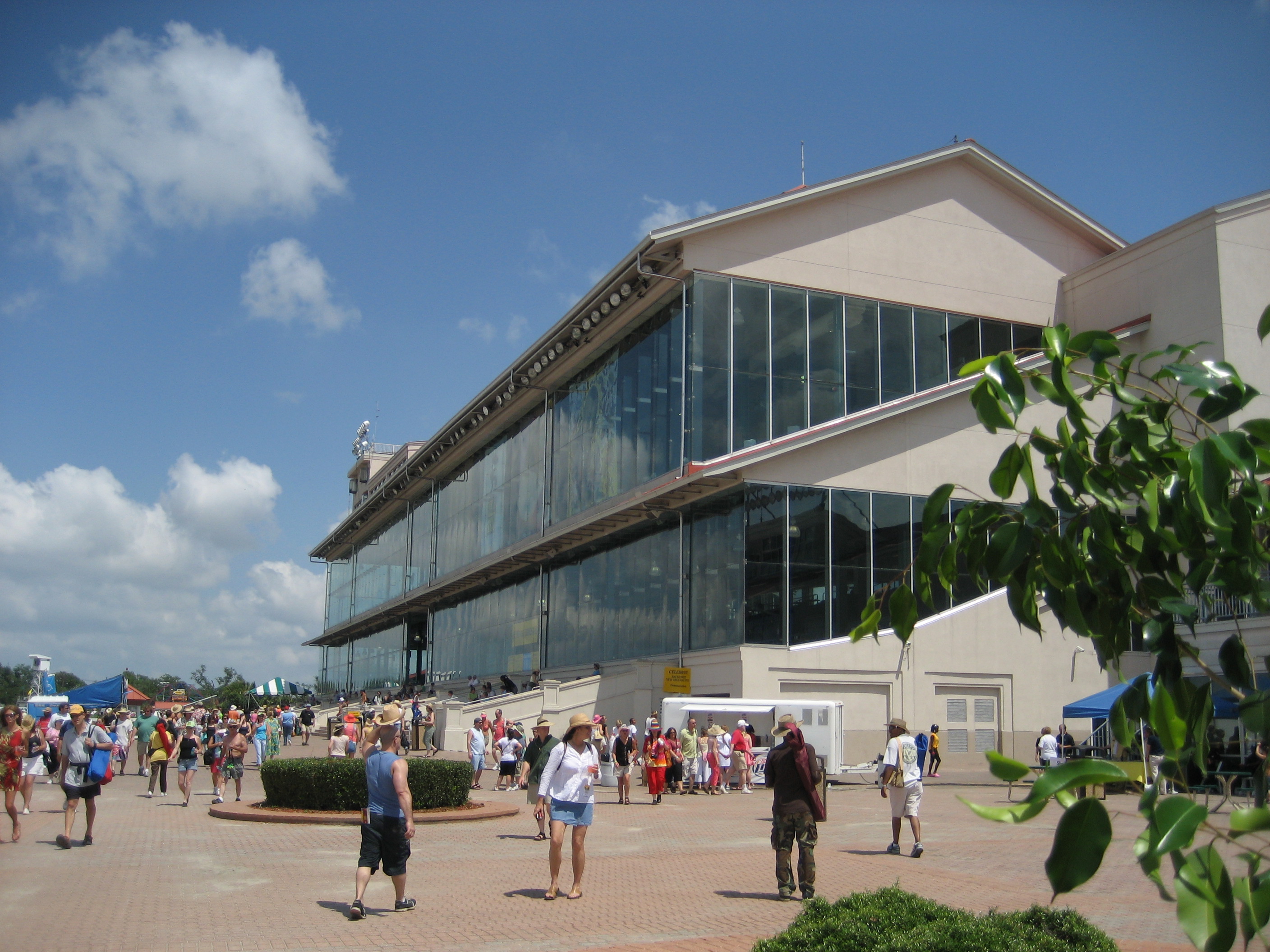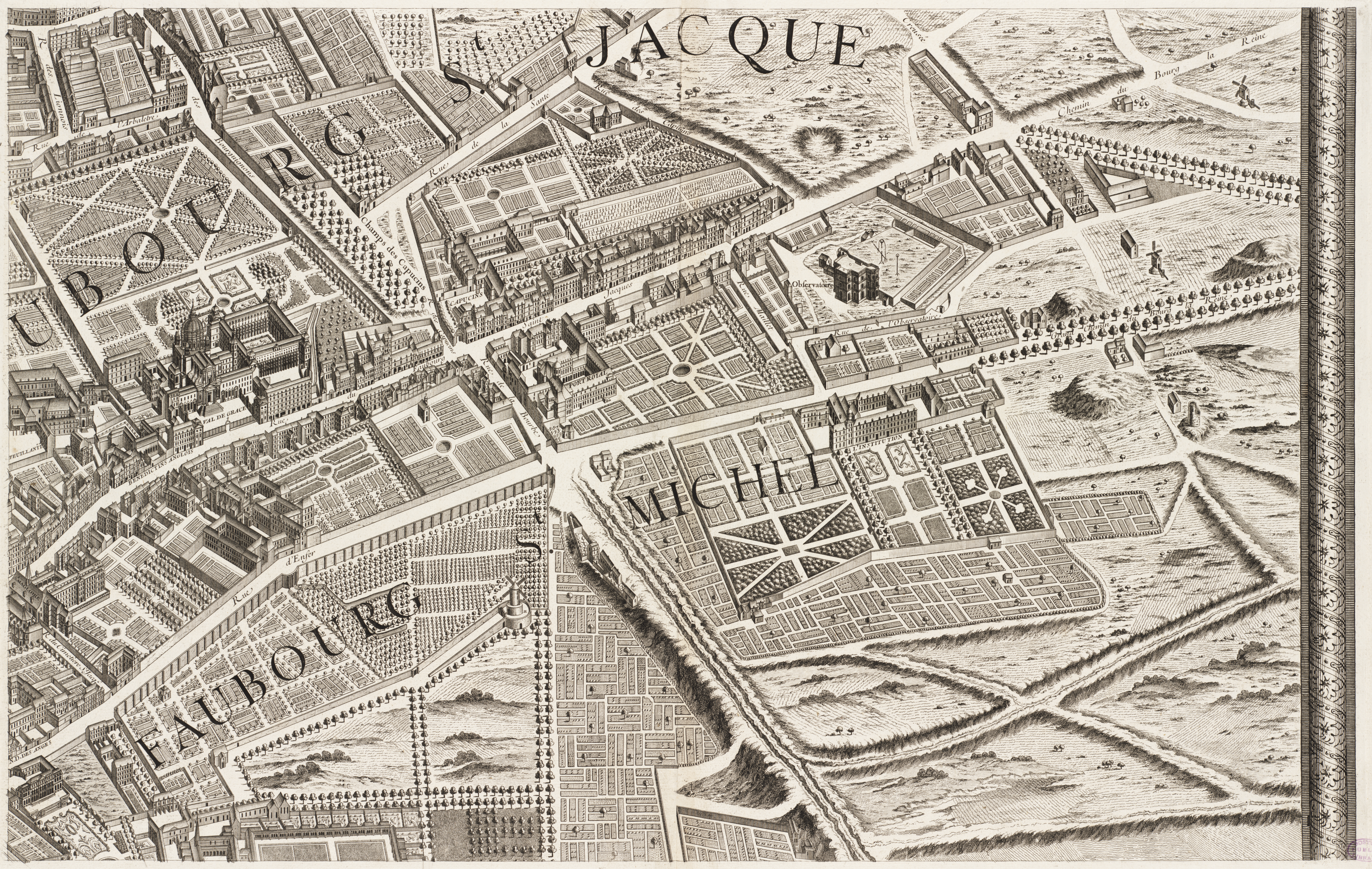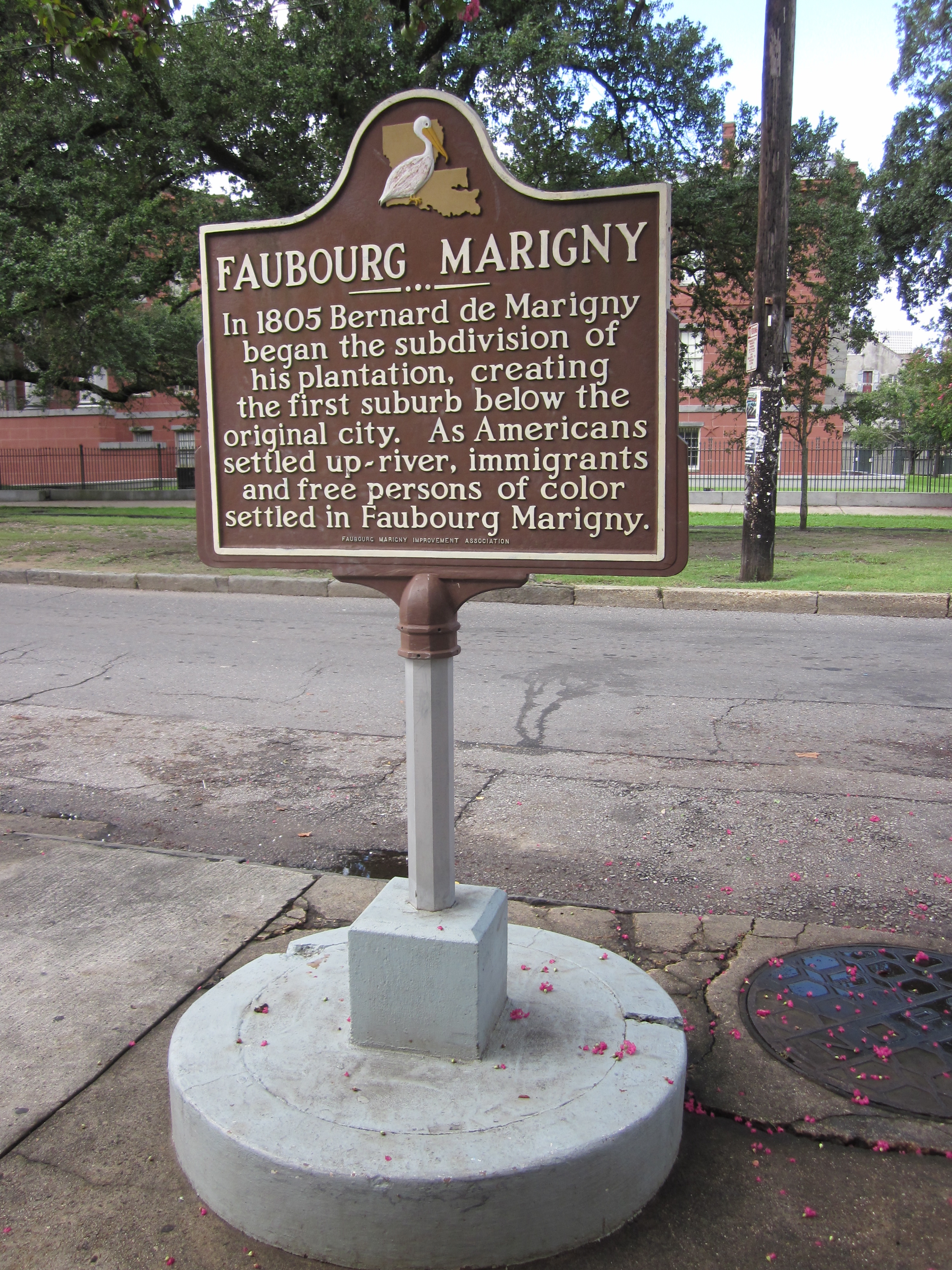|
Esplanade Avenue, New Orleans
Esplanade Avenue is a historic street in New Orleans, Louisiana. It runs northwest from the Mississippi River to Beauregard Circle at the entrance to City Park. History Esplanade Avenue was an important 18th-century portage route of trade between Bayou St. John, which linked to Lake Pontchartrain, and the River. Many 19th-century mansions still line the street; it functioned as a "millionaires row" for the Creole section of the city similar to that of St. Charles Avenue for the Anglophone section in uptown New Orleans. Esplanade Avenue is the dividing line between the 6th and 7th Wards of the city. From the River to Claiborne Avenue, Esplanade has one lane of traffic in both directions, with a raised neutral ground (median) in the center. From Claiborne to Carrollton Avenue it has one traffic lane in each direction, a dedicated bicycle lane, and a smaller neutral ground. The segment from the River to Rampart Street separates the French Quarter from the Faubourg Marigny. Ne ... [...More Info...] [...Related Items...] OR: [Wikipedia] [Google] [Baidu] |
New Orleans
New Orleans ( , ,New Orleans Merriam-Webster. ; french: La Nouvelle-Orléans , es, Nueva Orleans) is a Consolidated city-county, consolidated city-parish located along the Mississippi River in the southeastern region of the U.S. state of Louisiana. With a population of 383,997 according to the 2020 U.S. census, it is the List of municipalities in Louisiana, most populous city in Louisiana and the twelfth-most populous city in the southeastern United States. Serving as a List of ports in the United States, major port, New Orleans is considered an economic and commercial hub for the broader Gulf Coast of the United States, Gulf Coast region of the United States. New Orleans is world-renowned for its Music of New Orleans, distinctive music, Louisiana Creole cuisine, Creole cuisine, New Orleans English, uniq ... [...More Info...] [...Related Items...] OR: [Wikipedia] [Google] [Baidu] |
Claiborne Avenue
Claiborne Avenue is a major thoroughfare in New Orleans, Louisiana. It runs the length of the city, about , beginning at the Jefferson Parish line and ending at the St. Bernard Parish line; the street continues under different names in both directions. It is called ''South Claiborne Avenue'' upriver from Canal Street and ''North Claiborne Avenue'' from Canal to St. Bernard Parish. New Orleans' longest street was named in honor of William C. C. Claiborne, the first United States governor of Louisiana, serving during both the territorial period and as the first governor under statehood. New Orleans was the capital city in those days of the early 19th century. Route description Claiborne Avenue can be divided into three general sections as it winds through the city, following the curves of the Mississippi River. The Crescent For the first few miles in the city coming from Jefferson Parish, Claiborne Avenue is part of U.S. Highway 90; before crossing the parish line it is cal ... [...More Info...] [...Related Items...] OR: [Wikipedia] [Google] [Baidu] |
List Of Streets Of New Orleans
New Orleans, Louisiana Louisiana , group=pronunciation (French: ''La Louisiane'') is a state in the Deep South and South Central regions of the United States. It is the 20th-smallest by area and the 25th most populous of the 50 U.S. states. Louisiana is borde ..., United States, U.S.A., includes such notable streets as: * Allen Toussaint Boulevard * Almonaster Road, Almonaster Avenue * Audubon Place (New Orleans, Louisiana), Audubon Place (private access only) * Baronne Street * Basin Street * Bayou Road * Bienville Street * Bourbon Street * Broad Street, New Orleans, Broad Street * Burgundy Street * Calliope Street * Camp Street * Canal Boulevard (New Orleans), Canal Boulevard * Canal Street, New Orleans, Canal Street * Carondelet Street * Carrollton Avenue * Chartres Street * City Park Avenue * Claiborne Avenue * Conti Street * Dante Street * Dauphine Street * Decatur Street (New Orleans), Decatur Street * Desire Street * Dryades Street * Dumaine Street * Earhart Expr ... [...More Info...] [...Related Items...] OR: [Wikipedia] [Google] [Baidu] |
Buildings And Architecture Of New Orleans
The buildings and architecture of New Orleans are reflective of its history and multicultural heritage, from Creole cottages to historic mansions on St. Charles Avenue, from the balconies of the French Quarter to an Egyptian Revival U.S. Customs building and a rare example of a Moorish revival church. The city has fine examples of almost every architectural style, from the baroque Cabildo to modernist skyscrapers. Domestic architectural styles Creole cottage Creole cottages are scattered throughout the city of New Orleans, with most being built between 1790 and 1850. The majority of these cottages are found in the French Quarter, the surrounding areas of Faubourg Marigny, the Bywater, and Esplanade Ridge. Creole cottages are 1½-story, set at ground level. They have a steeply pitched roof, with a symmetrical four-opening façade wall and a wood or stucco exterior. They are usually set close to the property line. American townhouse Many buildings in the American townhou ... [...More Info...] [...Related Items...] OR: [Wikipedia] [Google] [Baidu] |
New Orleans Museum Of Art
The New Orleans Museum of Art (or NOMA) is the oldest fine arts museum in the city of New Orleans. It is situated within City Park, a short distance from the intersection of Carrollton Avenue and Esplanade Avenue, and near the terminus of the "Canal Street - City Park" streetcar line. It was established in 1911 as the Delgado Museum of Art. Museum The New Orleans Museum of Art (NOMA) was initially funded through a charitable grant by local philanthropist and art collector Isaac Delgado. The museum building itself was partly designed by the former chief engineer of New Orleans Benjamin Morgan Harrod. At the age of 71 Isaac Delgado, a wealthy sugar broker, wrote to the City Park Board about his intention to build an art museum in New Orleans. "I have been led to believe that you would willingly donate in the park the site for a building I propose erecting to be known as the 'Isaac Delgado Museum of Art'. My desire is to give to the citizens of New Orleans a fire proof buildi ... [...More Info...] [...Related Items...] OR: [Wikipedia] [Google] [Baidu] |
Edgar Degas
Edgar Degas (, ; born Hilaire-Germain-Edgar De Gas, ; 19 July 183427 September 1917) was a French Impressionist artist famous for his pastel drawings and oil paintings. Degas also produced bronze sculptures, prints and drawings. Degas is especially identified with the subject of dance; more than half of his works depict dancers. Although Degas is regarded as one of the founders of Impressionism, he rejected the term, preferring to be called a realist,Gordon and Forge 1988, p. 31 and did not paint outdoors as many Impressionists did. Degas was a superb draftsman, and particularly masterly in depicting movement, as can be seen in his rendition of dancers and bathing female nudes. In addition to ballet dancers and bathing women, Degas painted racehorses and racing jockeys, as well as portraits. His portraits are notable for their psychological complexity and their portrayal of human isolation. At the beginning of his career, Degas wanted to be a history painter, a calling f ... [...More Info...] [...Related Items...] OR: [Wikipedia] [Google] [Baidu] |
New Orleans Fairgrounds
Fair Grounds Race Course, often known as New Orleans Fair Grounds, is a thoroughbred racetrack and racino in New Orleans, Louisiana. It is operated by Churchill Downs Louisiana Horseracing Company, LLC. As early as 1838 Bernard de Marigny, Julius C Branch and Henry Augustine Tayloe, organized races at the "Louisiana Race Course" laid out on Gentilly Road, making it the second oldest site of horseracing in America still in operation, after Freehold Raceway and before the Saratoga Race Course. It began on April 10 and lasted for five days. In 1852 it was renamed the Union Race Course. In 2009, the Horseplayers Association of North America introduced a rating system for 65 Thoroughbred racetracks in North America. Of the top Fifteen, New Orleans Fair Grounds was ranked #12, behind Evangeline Downs in Opelousas, Louisiana, which was ranked #6. History In 1838 on April 10 Bernard de Marigny, Julius C Branch and Henry Augustine Tayloe (son of John Tayloe III of The Octagon House, a n ... [...More Info...] [...Related Items...] OR: [Wikipedia] [Google] [Baidu] |
Faubourg St
"Faubourg" () is an ancient French term historically equivalent to " fore-town" (now often termed suburb or ). The earliest form is , derived from Latin , 'out of', and Vulgar Latin (originally Germanic) , 'town' or 'fortress'. Traditionally, this name was given to an agglomeration forming around a throughway leading outwards from a city gate, and usually took the name of the same thoroughfare within the city. As cities were often located atop hills (for defensive purposes), their outlying communities were frequently lower down. Many faubourgs were located outside the city walls, and "suburbs" were further away from this location (, "below"; , "city"). Faubourgs are sometimes considered the predecessor of European suburbs, into which they sometimes evolved in the 1950s and 1960s, while others underwent further urbanisation. Although early suburbs still conserved some characteristics related to faubourgs (such as the back alleys with doors, little break margins for houses), late ... [...More Info...] [...Related Items...] OR: [Wikipedia] [Google] [Baidu] |
Faubourg Treme
"Faubourg" () is an ancient French language, French term historically equivalent to "fore-town" (now often termed suburb or ). The earliest form is , derived from Latin , 'out of', and Vulgar Latin (originally Germanic) , 'town' or 'fortress'. Traditionally, this name was given to an agglomeration forming around a throughway leading outwards from a city gate, and usually took the name of the same thoroughfare within the city. As cities were often located atop hills (for defensive purposes), their outlying communities were frequently lower down. Many faubourgs were located outside the city walls, and "suburbs" were further away from this location (, "below"; , "city"). Faubourgs are sometimes considered the predecessor of European suburbs, into which they sometimes evolved in the 1950s and 1960s, while others underwent further urbanisation. Although early suburbs still conserved some characteristics related to faubourgs (such as the back alleys with doors, little break margins fo ... [...More Info...] [...Related Items...] OR: [Wikipedia] [Google] [Baidu] |
New Orleans Mint
The New Orleans Mint (french: Monnaie de La Nouvelle-Orléans) operated in New Orleans, Louisiana, as a branch mint of the United States Mint from 1838 to 1861 and from 1879 to 1909. During its years of operation, it produced over 427 million gold and silver coins of nearly every American denomination, with a total face value of over US$ 307 million. It was closed during most of the American Civil War and Reconstruction. After it was decommissioned as a mint, the building has served a variety of purposes, including as an assay office, a United States Coast Guard storage facility, and a fallout shelter. Since 1981 it has served as a branch of the Louisiana State Museum. Damaged by Hurricane Katrina in 2005, after over two years of repairs and renovations, the museum reopened in October 2007. Exhibits include instruments used by some of New Orleans' notable jazz musicians, photographs, and posters, now part of the New Orleans Jazz Museum. The site is also a performance venue ... [...More Info...] [...Related Items...] OR: [Wikipedia] [Google] [Baidu] |
Faubourg Marigny
The Faubourg Marigny ( ; sometimes called The Marigny) is a neighborhood of the city of New Orleans, Louisiana, United States. Its boundaries, as defined by the City Planning Commission, are North Rampart Street and St. Claude Avenue to the north, the railroad tracks along Homer Plessy Way (formerly Press Street) to the east, the Mississippi River to the south, and Esplanade Avenue to the west. Geography The Faubourg Marigny is located at and has an elevation of . According to the United States Census Bureau, the district has a total area of . of which is land and (6.06%) of which is water. In the 19th century, the Faubourg Marigny was the old Third Municipality of New Orleans. The triangular area between Esplanade and Elysian Fields Avenue is sometimes called the ''Marigny Triangle'' and is part of the 7th Ward of New Orleans. The remainder is in the 8th and 9th wards of New Orleans. Adjacent neighborhoods * Seventh Ward (north) * St. Roch (north) * Bywater (east) * ... [...More Info...] [...Related Items...] OR: [Wikipedia] [Google] [Baidu] |
French Quarter
The French Quarter, also known as the , is the oldest neighborhood in the city of New Orleans. After New Orleans (french: La Nouvelle-Orléans) was founded in 1718 by Jean-Baptiste Le Moyne de Bienville, the city developed around the ("Old Square" in English), a central square. The district is more commonly called the French Quarter today, or simply "The Quarter," related to changes in the city with American immigration after the 1803 Louisiana Purchase. Most of the extant historic buildings were constructed either in the late 18th century, during the city's period of Spanish rule, or were built during the first half of the 19th century, after U.S. purchase and statehood. The district as a whole has been designated as a National Historic Landmark, with numerous contributing buildings that are separately deemed significant. It is a prime tourist destination in the city, as well as attracting local residents. Because of its distance from areas where the levee was breached during ... [...More Info...] [...Related Items...] OR: [Wikipedia] [Google] [Baidu] |





.jpg)



